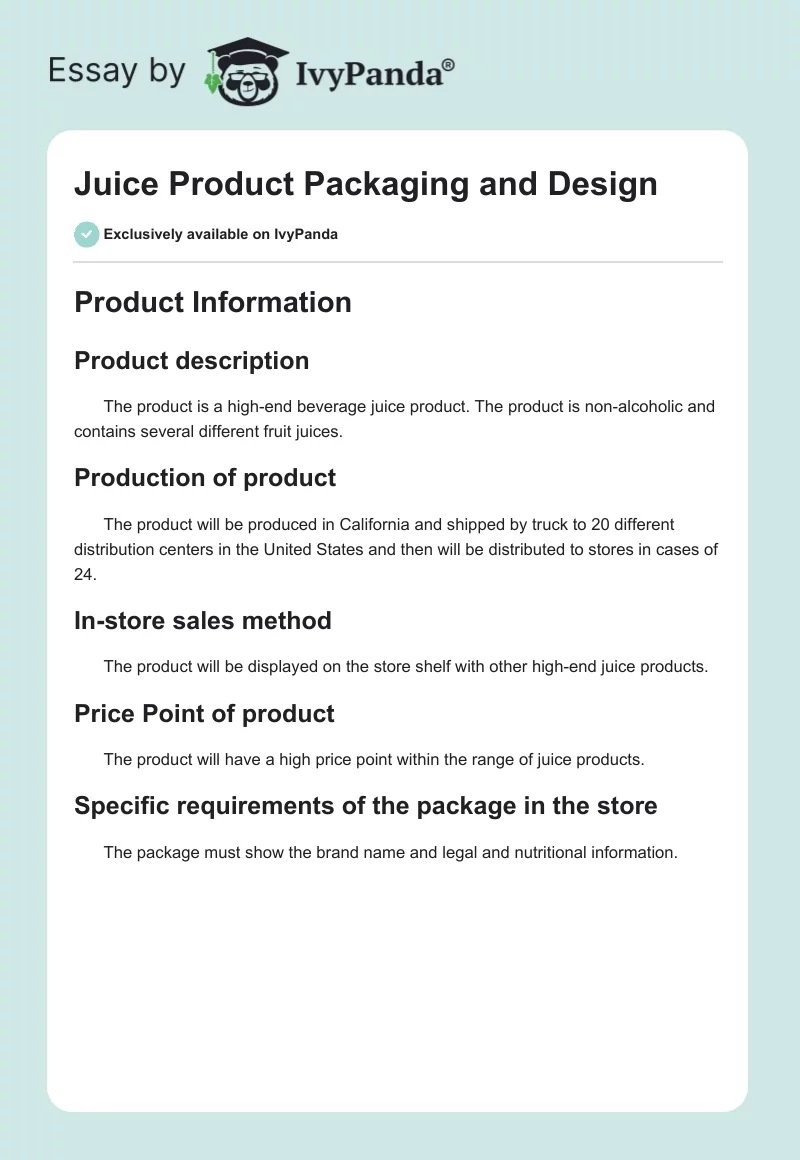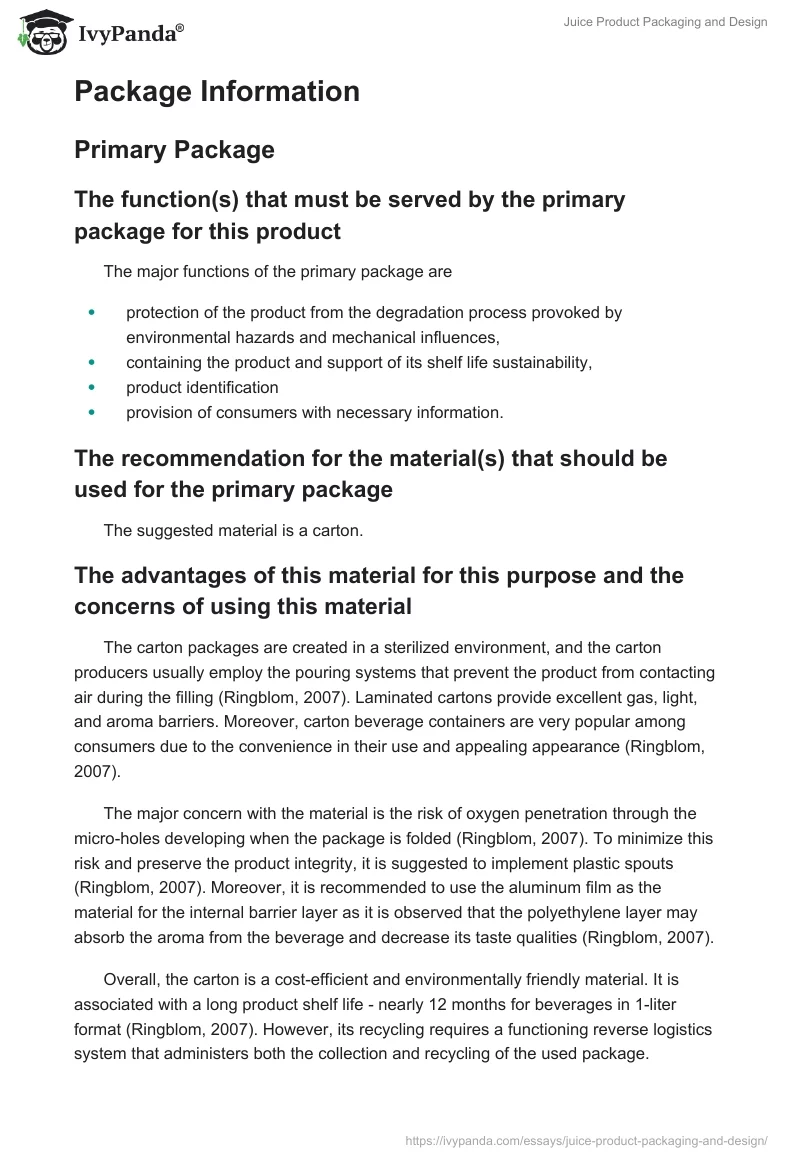Product Information
Product description
The product is a high-end beverage juice product. The product is non-alcoholic and contains several different fruit juices.
Production of product
The product will be produced in California and shipped by truck to 20 different distribution centers in the United States and then will be distributed to stores in cases of 24.
In-store sales method
The product will be displayed on the store shelf with other high-end juice products.
Price Point of product
The product will have a high price point within the range of juice products.
Specific requirements of the package in the store
The package must show the brand name and legal and nutritional information.
Package Information
Primary Package
The function(s) that must be served by the primary package for this product
The major functions of the primary package are
- protection of the product from the degradation process provoked by environmental hazards and mechanical influences,
- containing the product and support of its shelf life sustainability,
- product identification
- provision of consumers with necessary information.
The recommendation for the material(s) that should be used for the primary package
The suggested material is a carton.
The advantages of this material for this purpose and the concerns of using this material
The carton packages are created in a sterilized environment, and the carton producers usually employ the pouring systems that prevent the product from contacting air during the filling (Ringblom, 2007). Laminated cartons provide excellent gas, light, and aroma barriers. Moreover, carton beverage containers are very popular among consumers due to the convenience in their use and appealing appearance (Ringblom, 2007).
The major concern with the material is the risk of oxygen penetration through the micro-holes developing when the package is folded (Ringblom, 2007). To minimize this risk and preserve the product integrity, it is suggested to implement plastic spouts (Ringblom, 2007). Moreover, it is recommended to use the aluminum film as the material for the internal barrier layer as it is observed that the polyethylene layer may absorb the aroma from the beverage and decrease its taste qualities (Ringblom, 2007).
Overall, the carton is a cost-efficient and environmentally friendly material. It is associated with a long product shelf life – nearly 12 months for beverages in 1-liter format (Ringblom, 2007). However, its recycling requires a functioning reverse logistics system that administers both the collection and recycling of the used package.
The recommended method of printing for the primary package
The suggested printing method is flexography.
The advantages of this print method for this package and the concerns of using this print method
The flexible photopolymer plates are used for flexography. Such forms have some advantages comparing to the forms used in other types of printing. They are associated with a flexible configuration of forms for printing in different sizes and a high run length (Advantages of flexographic printing, n.d.). Environmentally friendly paints used in this printing process allow printing images on various types of food packaging including laminated cartons. Other advantages of flexography include high speed of printing without loss in quality, the relative simplicity of the process, cost-effectiveness in the release of the printed products in the medium and long runs, as well as low production costs (low paint consumption, simple process) (Advantages of flexographic printing, n.d.).
The major disadvantages of flexography are the long changeover and set-up time and the high cost of printing plates (Fissel, 2013). Therefore, this technique is cost-inefficient for small runs. Nevertheless, it is one of the best options for printing packaging in larger volumes with increased quality of color, and image definition which help to create an appealing design of the product package.
Assumptions in choosing the material or print method
It is expected that the selected material and printing technique will ensure a high level of product safety and protection during shipment, will allow maintenance of its high-quality features, and strengthening its competitive position in the market by distinguishing the juice from similar products.
Environmental concerns that must be addressed for the primary packaging
It is observed that “recycling of cartons vary greatly between countries, from 10 to 90 %, depending on the collection and recycling systems in place” (Ringblom, 2007, p. 280). Nowadays, such carton producers as Tetra Pack integrate the principles of environmental excellence and provide opportunities for recycling the used beverage cartons in the USA and around the globe. Since the product will be consumed by individuals, the organization will not be able to collect and recycle the packaging in an organized way, but it can provide the consumers with relevant information regarding disposal of the used juice boxes and potential methods for its recycling.
Secondary Package
The function(s) that must be served by the secondary package for this product
The major functions of the secondary package are
- containment of the pre-packed merchandise,
- protection and preservation of the cases from mechanical damage,
- convenience of movement and shipment, and
- product identification.
The recommendation for the material(s) that should be used for the secondary package
The recommended material is cardboard.
The advantages of this material for this purpose and the concerns of using this material
The consideration of logistics and environmental costs defines the selection of cardboard as an effective material for secondary packaging. The benefits associated with the use of cardboard include its lightweight, affordability, facilitated labeling and printing, and eco-friendliness (Pros & cons of corrugated cardboard boxes, 2015). However, cardboard is characterized by a lower degree of resistance to high pressures and may not be suitable for long-term use. Nevertheless, as a secondary packaging material, it will be used for a shorter-term purpose – transportation and pre-sale storage.
The recommended method of printing for the primary package
Flexographic printing is recommended.
The advantages of this print method for this package and the concerns of using this print method
Cardboard is characterized by a high degree of absorbency which may interfere with the obtaining of a high-definition image in flexography (Print types, 2016). However, printing on the secondary packaging does not necessarily require high-definition – the design of a cardboard package may employ a few colors and straight text. Although lithography may ensure the obtainment of higher quality customized images in complex product designs, flexographic printing on cardboard in large production runs is still more appropriate than digital printing as it is more economical (Twede, Selke, Kamdem, & Shires, 2015).
Assumptions in choosing the material or print method
It is expected that the selection of the lighter weighted material such as cardboard will lead to the reduction of logistics costs. In this way, at the same time, while focusing on the product quality, the organization will maintain cost-efficiency throughout manufacturing and shipping processes. Moreover, the selection of cardboard as a secondary container is consistent with the principles of green logistics which plays an important role in meeting social needs for environmental sustainability and is linked to the development of positive brand awareness among consumers (Ho & Lin, 2012).
Environmental concerns that must be addressed for the primary packaging
Cardboard has an environmentally friendly reputation – it is recyclable and biodegradable. However, its use is associated with some environmental costs as well. Cardboard production involves an energy-intensive process of wood harvesting, provokes air and water pollution, and creates by-products with low value (Twede et al., 2015). To minimize the environmental risks, the company may utilize the recycled materials for the production of packaging and administer the reverse logistics operations which will help to coordinate the collection of the used secondary packaging materials among the parties involved in the distribution process and, in this way, facilitate their recycling.
References
Advantages of flexographic printing. (n.d.). Web.
Commissioner Europea. (n.d.). Food and beverage packaging: Main issues. Imagine. Web.
Fissel, C. (2013). Digital label printing vs. flexographic label printing. Valley Forge. Web.
Ho, Y., & Lin, C. (2012). An empirical study on Taiwanese logistics companies’ attitudes toward environmental management practices. Advances in Management & Applied Economics, 2(4), 223-241.
Print types. (2016). Web.
Pros & cons of corrugated cardboard boxes for packing & moving. (2015). Web.
Ringblom, U. (2007). Selecting the ideal packaging for fruit-based beverages. Web.
Twede, D., Selke, S., Kamdem, D. P., & Shires, D. (2015). Cartons, crates and corrugated board: Handbook of paper and wood packaging technology. Lancaster, PA, U.S.A.: DEStech Publications.


